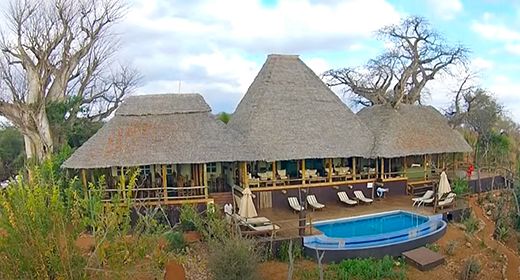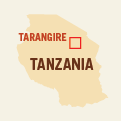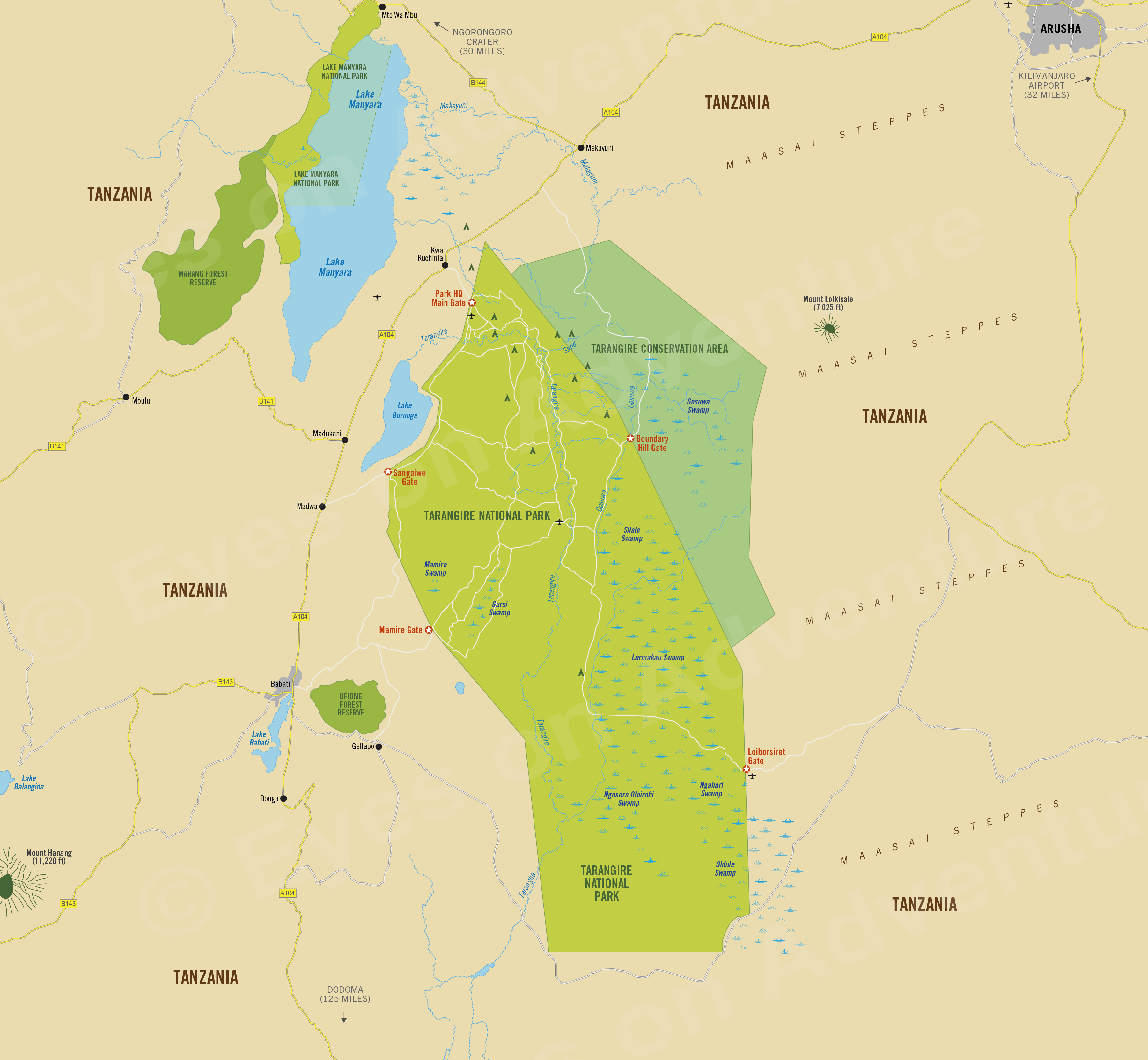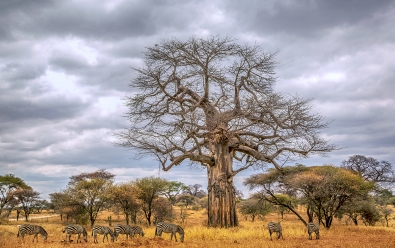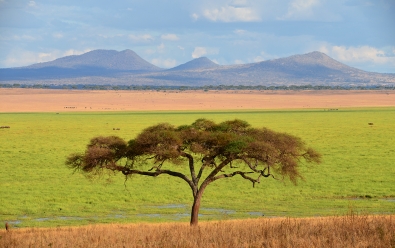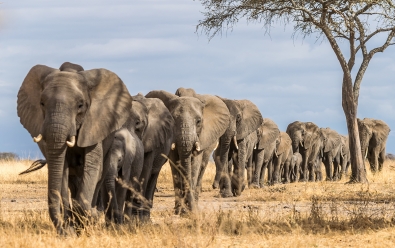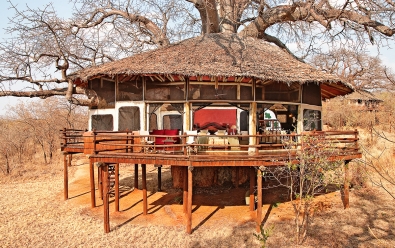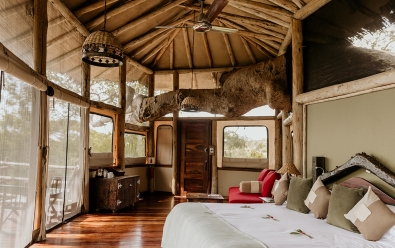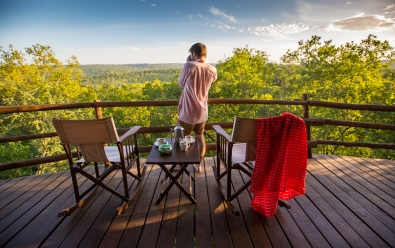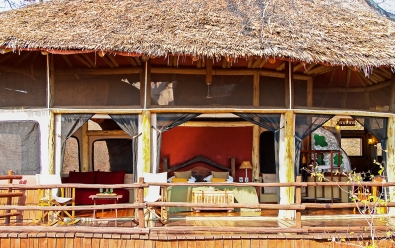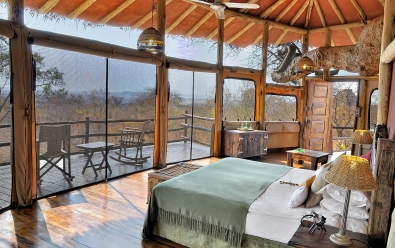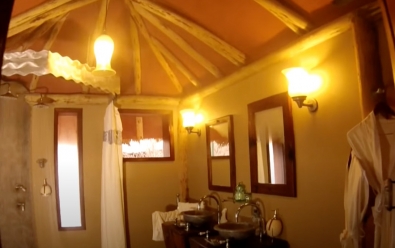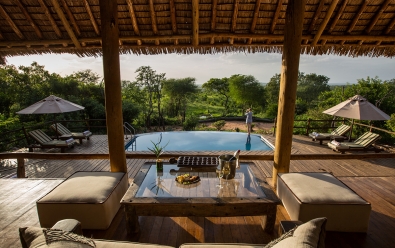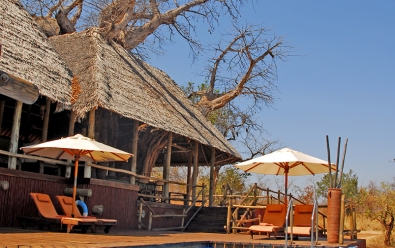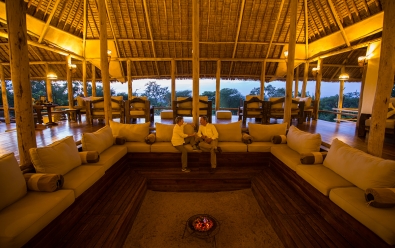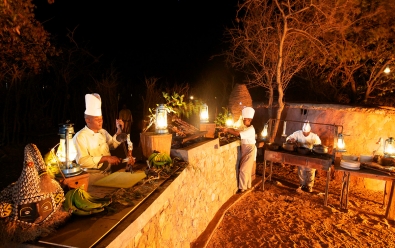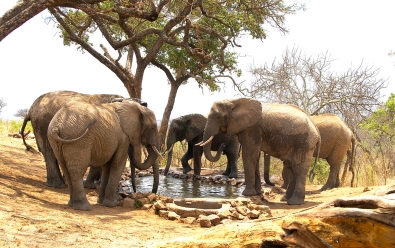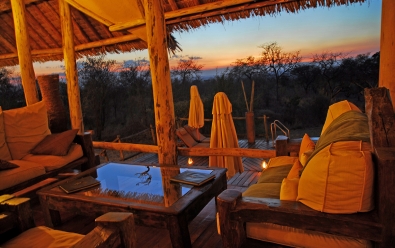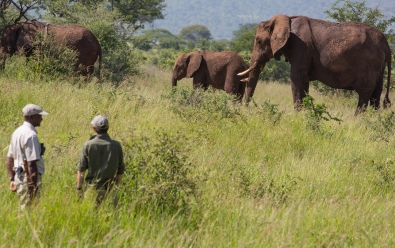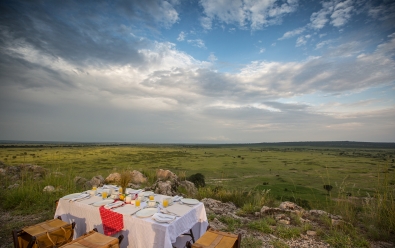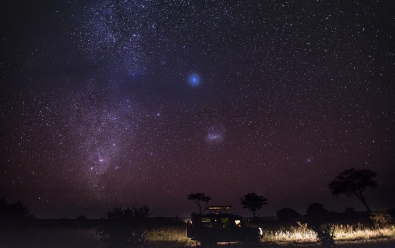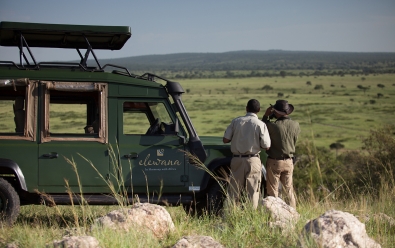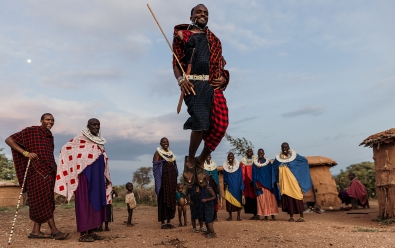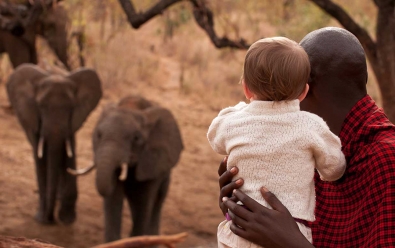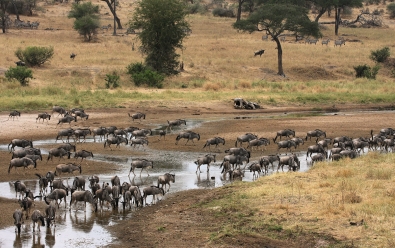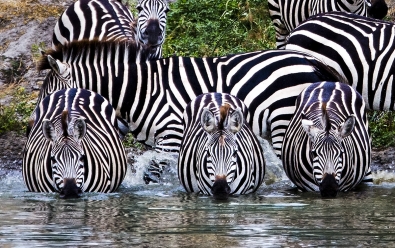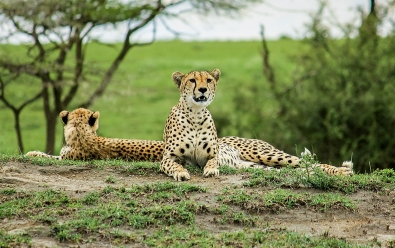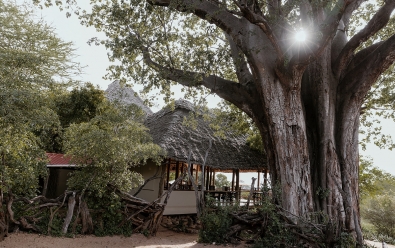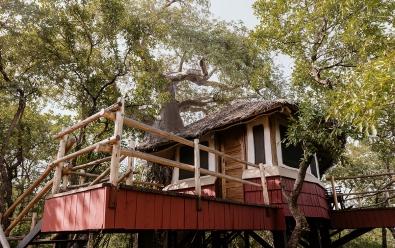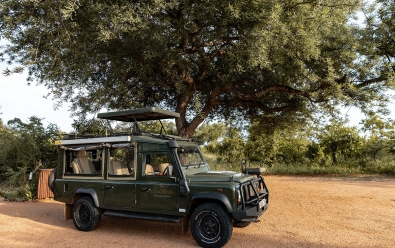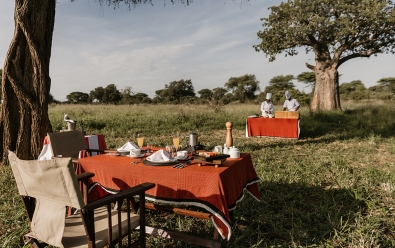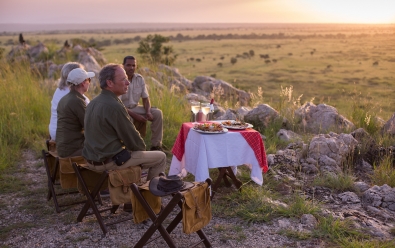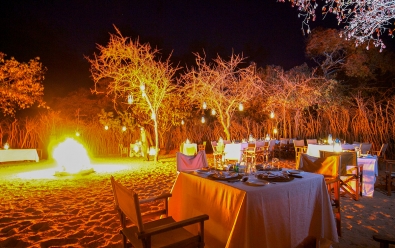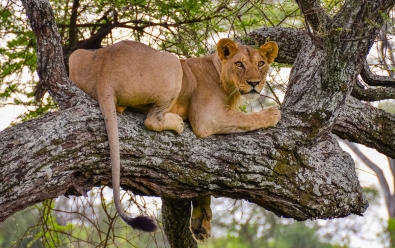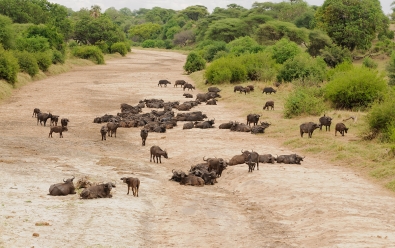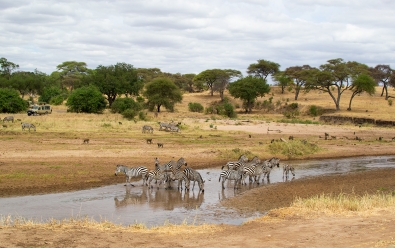Tarangire Treetops
Location
- Tarangire Conservation Area
- Bordering Tarangire NP
- Northern Tanzania
Tarangire Treetops is located in a private, wildlife-rich reserve bordering Tarangire National Park. The camp's name refers to its elevated "treetop" guest rooms.
The camp is situated in the Randilen Wildlife Management Area (WMA), which is one of numerous WMAs that comprise the Tarangire Conservation Area (TCA). The TCA borders Tarangire National Park and includes the main watershed for the Tarangire River. The national park was proclaimed to provide protection for this river, which is the life-source for the region's abundant wildlife and the reason for the 'Tarangire Migration' (read more about the wildlife and migration below).
Tarangire is an oft-overlooked destination for safaris in northern Tanzania, but its deserves consideration, particularly during the dry, winter months between July and October, when Tarangire is absolutely pumping with wildlife, especially elephants.
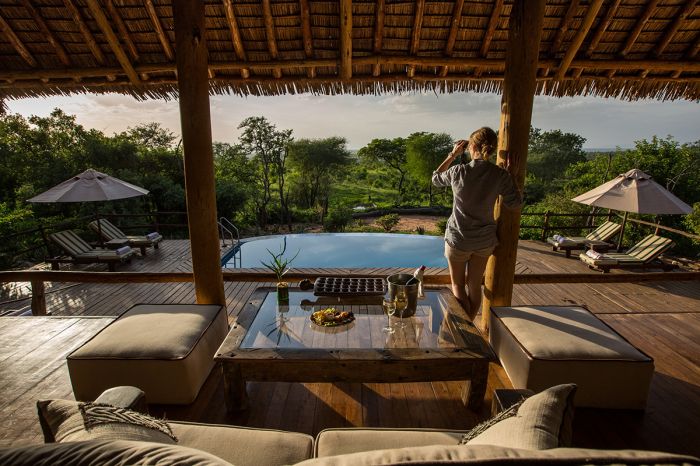
View from Tarangire Treetops lounge, showing the swimming pool and wildlife waterhole.
Activities at Tarangire Treetops focus on safari drives, but because the camp is located outside of the national park, guests can also partake in night drives and guided walking safaris. Drives into the national park are always an option. Cultural visits to one of the local Maasai villages are also offered. Children of any age are accommodated and child-friendly activities are offered.
The camp offers 20 'treetop' guest suites, each on well-raised wooden decks to allow for better views and giving the feeling of staying in a luxurious tree house. All tents can be converted into a triple room.
The camp's main lodge is built around a massive and ancient baobab tree, which are common around the region. There is a large swimming pool with sundeck and a pumped waterhole just below, which is frequented regularly by elephants and other wildlife.
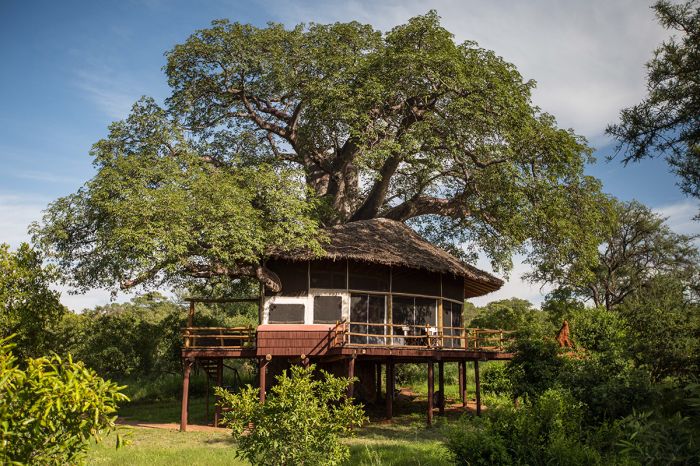
One of 20 "tree-top" guest suites at Tarangire Treetops.
About Tarangire
Tarangire is comprised of the Tarangire National Park and the adjoining Tarangire Conservation Area (TCA), which together occupy nearly 1 250 square miles (3 250 sq kms) of wilderness in Africa's Rift Valley. Tarangire is part of Tanzania's northern safari circuit, which also includes the Serengeti, Ngorongoro, and Lake Manyara regions.
Tarangire's core protected area is based around the Tarangire River, which flows north through the 1 010-square-mile (2 616-sq-km) Tarangire National Park before emptying into Lake Burunge, which lies just west of the northern section of the park. An additional 226 square miles (585 sq kms) is protected as the Tarangire Conservation Area (TCA). To the east are the Maasai Steppes, covering roughly 1 900 square miles (5 000 sq kms) of unprotected, but mostly uninhabited land.
The Tarangire region is drier than the Serengeti, with dense Acacia scrubland and woodlands, especially in the north and along the rivers. Tarangire's baobab trees are a notable feature in the northern area of the national park and TCA. Seasonal swamps dominate the southern half of the national park.
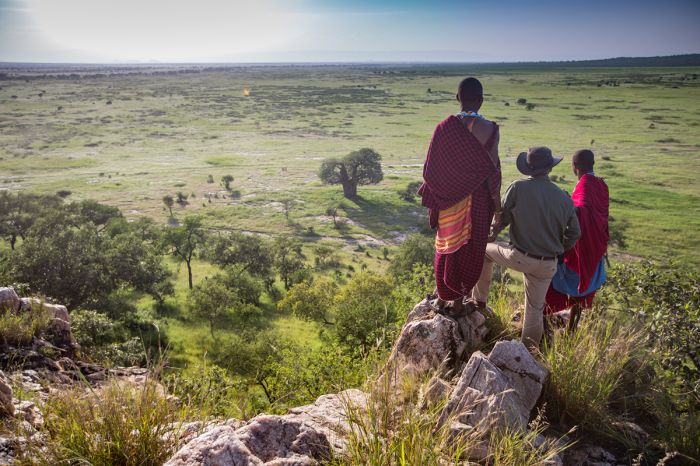
The view over Tarangire from atop Sunset Hill.
Tarangire National Park
Tarangire National Park was established in 1970 to protect the diversity of wildlife, birds, and habitats along the perennial Tarangire River. The northern portion of the park is the most developed and offers year-round safaris. The bend of the Tarangire River and its east-west portion is particularly good for wildlife.
The northern section is dominated by hilly grasslands, Acacia woodlands, patches of riparian woodland along the Tarangire River, and numerous baobab trees. The road network in the north is well established, with tracks running on either side of the Tarangire River.
Moving south, the park gradually becomes defined by seasonal marshes, which are a haven for birds. Most of the roads in this central portion of the park are passible all year, though some become difficult during the rainy season. The far south of the park is extremely remote and is only reachable during the dry season, but even then, it is seldom explored.
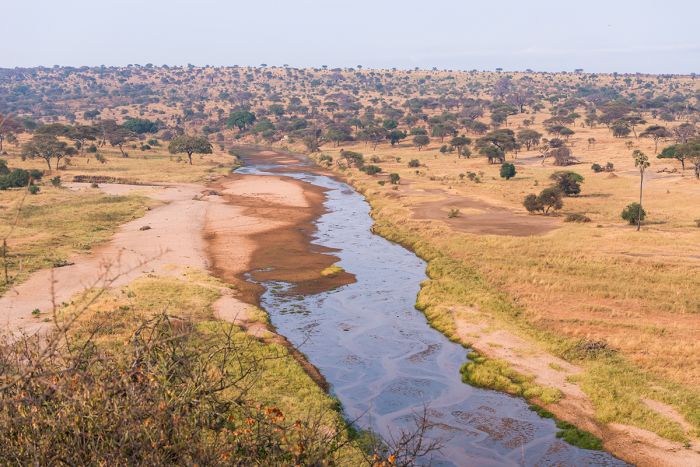
The Tarangire River provides water to the park's abundant wildlife.
The Tarangire River, which flows north through the entirety of the national park, is the life source for the entire region. Even during the peak of the dry season (August-October), when most of the region has little to no water, the mostly dry Tarangire riverbed still supports life-sustaining pools of water.
Wildlife from across the region congregate at the Tarangire River for its water, including large numbers of elephant, wildebeest, and zebra. The animals spend the dry months close to the river, providing excellent game viewing. Once the short rains begin in November, the animals disperse into the surrounding areas.
Tarangire's swamps are located in the central and southern reaches of the park and offer some of the country's richest breeding grounds for birds during the rainy season (between November and May). During the dry season (June-October), the swamps recede, but the remaining marshland offers superb game viewing, especially for buffalo, lion, and elephant.
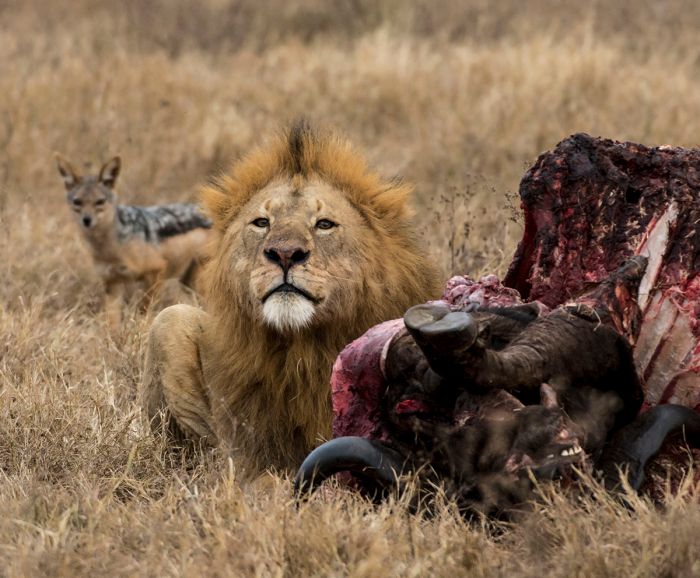
A male lion guards a buffalo kill as a black-backed jackal looks on - Tarangire National Park.
TARANGIRE CONSERVATION AREA (TCA)
Bordering Tarangire National Park in the northeast is the Tarangire Conservation Area (TCA). The TCA was established in the late 1990s as Tanzania's first community-managed wildlife area.
The TCA is comprised of multiple Wildlife Management Areas (WMAs) that are owned and managed by separate groups of Maasai communities. Some of the WMAs offer eco-tourism as a source of revenue for their land, while others are used for cattle grazing or mixed-use purposes.
The Tarangire River's primary watershed is found in the TCA and these seasonal "sand" rivers, provide pools of water during the dry season for an abundance of wildlife. Game viewing in the TCA can even surpass that in the national park.
The TCA is not subject to national park regulations, so night drives and walking safaris are an option at the safari camps located here.
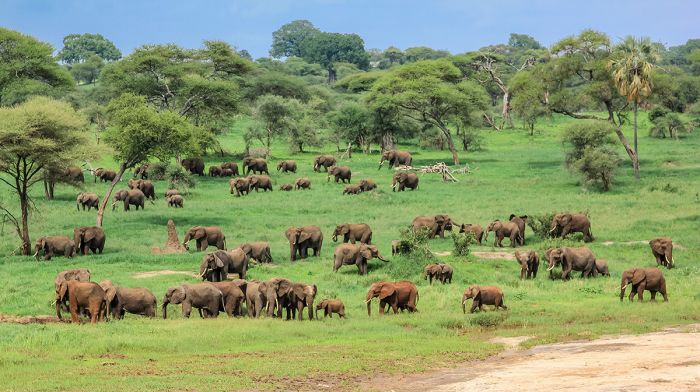
A large congregation of elephants in the Tarangire Conservation Area.
WILDLIFE & MIGRATION
Tarangire is home to a little-known wildlife migration, which is much smaller than the great Serengeti-Masai Mara migration. The annual migration at Tarangire consists of some 25 000 wildebeest, 30 000 Burchell's zebra, 2 500 elephant, and modest numbers of fringe-eared oryx. The concentration of mammals in Tarangire during the dry season months (July-October) is second only to the Serengeti and Ngorongoro Crater in Tanzania.
The migrating animals begin to arrive to the Tarangire region at the onset of the dry season (usually in late July) to take advantage of the remaining water and waterholes along the Tarangire River bed and its watershed tributaries. The migrating wildlife remain in Tarangire until the rains arrive, usually sometime in November. When the short rains in November begin in earnest, the zebras and wildebeests depart Tarangire, heading north to Lake Manyara or east into the Maasai Steppes.
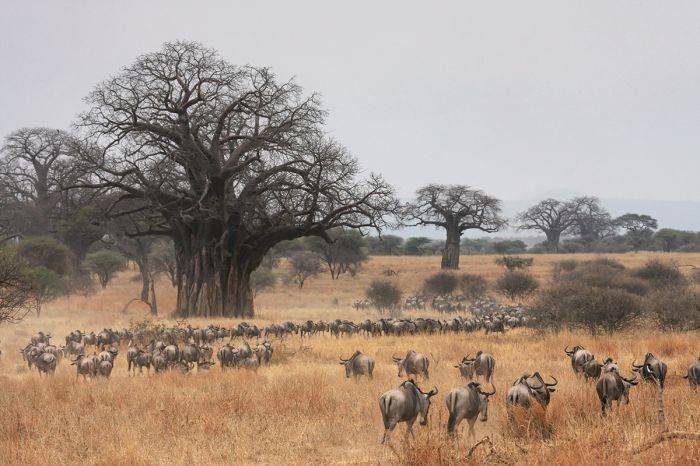
Tarangire's migration is present during the dry season.
By the time the long rains arrive in April/May, the migrating animals are spread out over a huge area roughly ten times the size of Tarangire National Park. Some elephants migrate all the way into Kilimanjaro and Amboseli National Park. When the long rains are over and the plains begin to dry up (usually between mid-May and early June), the animals start to head again towards Tarangire, where by August, they have arrived in huge numbers again.
Many of Tarangire's animals are year-round residents, including lion, leopard, buffalo, giraffe, zebra, eland, waterbuck, bushbuck, Thomson's gazelle, Coke's hartebeest, impala, warthog, hippo, black-backed jackal, ostrich, olive baboon, vervet monkey, and significant numbers of elephant. Cheetah are seen in Tarangire on occasion but are uncommon, as are spotted hyenas. Less common mammals include the odd-looking gerenuk antelope, with its extra long neck, lesser kudu, and striped hyena.
Birding in Tarangire is superb, with over 500 species recorded. The Tarangire River and the swamps are especially productive birding areas. West of the park's boundary is Lake Burunge, which attracts a variety of waterbirds all year and large numbers of flamingos during the dry season.
ROOMS INCLUDES & EXCLUDES CHILDREN FACILITIES ACTIVITIES
Accommodation
20 guest accommodations in total comprising:
- 20 canvas-tented suites on elevated platforms, each with two twin beds. Mattress converters are available that transform the twin beds into a double bed.
The spacious "treetop" suites are constructed on well-elevated wooden platforms using wooden support beams, walls of canvas, thatched roofing, and polished hard-wood flooring. Every tent includes en-suite facilities with a double-basin vanity, indoor double-shower, and separate flush toilet.
Five of the 20 rooms have ramps to access them from the ground while the remaining 15 rooms are accessed by stairs. The tents are connected to the main camp area by footpaths on the ground.
All of the tents can be fitted with an extra bed to accommodate a child up to 17 years of age.
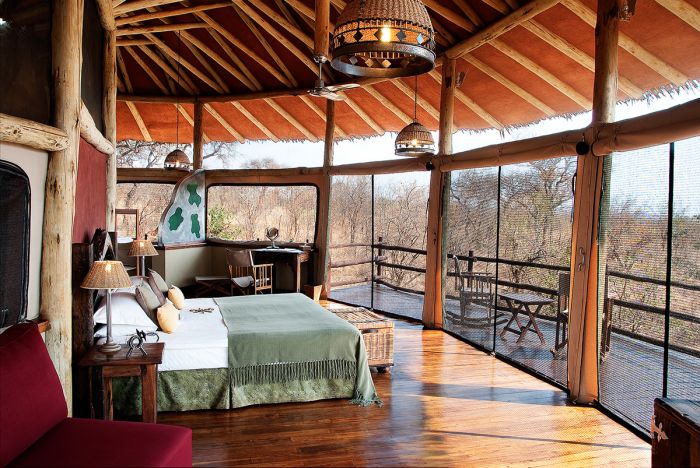
Guest suite interior and view.
The guest suites are built on raised platforms (some of ramps while others have stairs) to give guests the feeling of staying in a luxurious treehouse. The rooms are either sunset-facing, sunrise-facing, or overlook the camp's wildlife waterhole.
Each guest suite has a large wooden veranda in front, which is accessed by rollup-canvas flaps and zip-up mesh screening. Wildlife is commonly seen visiting the camp's pumped waterhole or in the surrounding open woodland.
The suite interiors are decorated with hand-made African decor and furniture and includes a small indoor lounge area with a comfortable couch.
The guest rooms are spacious, covering 667 square feet (62 sq meters) of indoor space and 797 square feet (74 sq meters) with the outdoor balconies.
Other items and features in the guest tents include:
- Writing desk and chair.
- Lounge area.
- 24-hour lighting and charging capabilities in the rooms.
- Bathrobes and slippers.
- Hairdryer.
- Ceiling fan.
- Safe.
- WiFi available in the main guest area.
- Mobile phone signal available, but limited.
Tarangire Treetops can accommodate a maximum of 40 guests in total: 2 persons in each of the treehouse suites. Additional children may be accommodated, as all tents are convertible to triples.
Includes & Excludes
Includes:
- All meals and local beverages including soft drinks, house wines, local brand spirits and beers, teas, and coffees.
- Safari experiences (twice-daily game drives, walking safaris, and birding) accompanied by an experienced guide.
- Laundry services are provided on a daily basis (weather permitting, items will be returned on the same day). Laundry is dried by the sun and on most days any laundry placed out in the morning will be returned by the evening.
- Wi-Fi access (throughout the entire camp).
- Kuro Airstrip transfers.
- Tourism Levy & VAT.
Excludes:
- Champagne, cognacs, fine wines, premium brand spirits, and cigars.
- Night game drive fee charged by the reserve.
- Purchases from the Gift Shop.
- Any applicable wildlife fee, park fee, reserve fee, concession fee, other land-use fee.
Single Supplement
A single supplement may apply for any room booked by a single traveler; please ask us for pricing.
Children
Children of any age are accommodated at Tarangire Treetops:
- All treehouse rooms are convertible to triples.
- Ask us about reduced rates for children sharing with adults or children 12-17 in their own tent.
- Child-friendly activities are offered.
- Children's menu available.
Some of the children's activities include:
- Swimming pool.
- Guided nature walks around the camp: short walks looking at the trees, flowers, grasses, insects, birds and bird calls, mammals, tracks, and droppings.
- Warrior training - Learning how to make a fire, throw the Maasai rungu, make and use a bow-and-arrow.
- Learn about the baobab tree, its African folklore, and its importance in the ecosystem, including all the animals that make it their home.
- Roasting marshmallows around the campfire.
Facilities
The camp and tents are well spaced out in an open woodland of baobab, mopane, and marula trees.
The main guest area consists of a spacious open-plan lodge constructed atop a raised wooden deck and beneath high-pitched thatched roofing. The area consists of a lounge, dining area, bar, and reception.
Part of the lodge is built around an ancient baobab (perhaps 1 000 years old), which grows through and well-above the roof. The lodge overlooks the camp's swimming pool and sundeck, as well as the camp's wildlife waterhole further below.
Main guest area facilities include:
- Lodge with bar, lounge, and dining spaces.
- Swimming pool and sundeck.
- Traditional boma for outdoor dining or sitting around the campfire.
- Gift Shop.
- Motorized buggy for transport to/from rooms and ramp access (instead of stairs) to five of the guest suites.
- Complimentary Wi-Fi access.
- Mineral water is provided from dispenser points in the main camp areas. Mineral water provided during meals and in guest rooms. Guests are issued with a refillable bottle.
- The camp is powered by generator which provides 24-hour power to the main area and guest rooms.
Activities
Activities included in the rate:
- Morning and afternoon/evening game drives in open 4x4 vehicles.
- Night drives also offered, but incur a reserve fee.
- Guided bush walks (at the discretion of the guide depending on the wildlife) Children under 16 years of age may be restricted.
- Cultural visits to a local Maasai village.
- Bush meals and sundowners.
- Birding.
- Child-friendly activities.
- All game drive vehicles fitted with inverters for battery charging on game drives.
Optional activities at additional cost:
- Private activities are on offer (subject to vehicle availability, which needs to be booked in advance).
Example of a typical day:
- Early morning wake-up call. Morning wake-up and activity times vary according to the seasons, activities on offer, and wildlife sightings.
- Light breakfast before departing on the morning activity or food packed for an earlier departure.
- Return to the lodge for a meal and rest period (full-day outings mean lunch is packed).
- Meet for afternoon tea and snacks (savory and sweet choices) before departing on the activity.
- Return to camp - freshen up or meet for drinks, followed by dinner.
- Enjoy a nightcap and/or discussion at the bar or around the campfire before retiring.
Great Good Fair Poor
- Jan
- Feb
- Mar
- Apr
- May
- Jun
- Jul
- Aug
- Sep
- Oct
- Nov
- Dec
General Tips
The best time to visit the Tarangire region is during the dry season, between June and October and into early November. The dry season is also the time when the relatively lesser known Tarangire migration (as opposed to the well-known Serengeti-Masai Mara migration) arrives to the region, greatly increasing the abundance of wildlife that is present (read more about this below).
As with most of northern Tanzania, most of Tarangire rainfall occurs between November and May and there are two somewhat distinct rain seasons, the 'short' rains and the 'long' rains (read more below).
Tarangire Treetops is open year-round. Minimum 2-night stay.
RAIN SEASON
Short Rains
The short rains occur for about one month sometime during November and December (the exact time varied somewhat year to year). This period is called the 'short' rains because the duration of an individual rain event is typically brief and it is rare to have an all-day rain event. Most rain falls as an afternoon shower, while mornings are typically overcast or clear.
Long Rains
The long rains occur between March and May, with April being the wettest month of the year. During this tome, rain should be expected almost every day and the showers can last for hours at a time, although all-day rain is not typical. The roads in Tarangire become muddy and very difficult in places, which can hamper game drives. Cloudy skies are typical and temperatures can be chilly at times.
The period between the short and long rains (January and February) also receives rain, but many days are clear and the amount and duration of the rain events is unpredictable, with some afternoon showers and the odd long and heavy rainfall event.
TEMPERATURES
The temperatures in the Tarangire do not have great variation throughout the year, as the region lies between 3 and 5 degrees south of the equator. In general, daytime temperatures are comfortably warm and overnights and early mornings are comfortable to somewhat chilly. Bring a fleece and rain jacket regardless of the timing of your visit.
Dry Season
The dry season (June to October) is sunny and warm most days and rarely hot. Rare rain showers can occur but are unlikely. From June thru October, the afternoon temperature averages 78-80°F (26-27°C), but some days can be warmer. Evenings and early mornings temperatures are often chilly, averaging 55-58°F (13-14°C).
Rainy Season
The rainy season is November through May (read more above) and the temperatures are slightly higher than in the dry season, remaining fairly static throughout the season. Daytime temperatures average 80-84°F (27-29°C) and nighttime and early morning temperatures are chilly, but slightly warmer than the dry season, averaging 59-62°F (15-17°C).
The Tarangire Migration
Contrasted with the much more well-known 'Great Migration' that occurs to the north in the Serengeti and Masai Mara grasslands, the Tarangire Migration is much smaller in terms of animal numbers and includes a greater variation os species.
The Serengeti migration is undertaken by only two species of herbivore: the blue wildebeest and the plains zebra. The number of animals in this great migration numbers around 1.5 million individuals. This migration occurs in an endlessly clockwise movement across the vast grasslands covering the Greater Serengeti-Mara of Tanzania and Kenya, as the animals constantly seek out fresh grazing.
The Tarangire Migration occurs when a variety of animals, including elephant, blue wildebeest, Grevy's zebra, eland, and fringe-eared oryx, arrive to the Tarangire region at the onset of the long dry season to survive on the region's only available remaining water at this time, which is the Tarangire River. Although the river does not actually flow above ground during this time, there are pools of water along its course and this is enough for thousands of animals to sustain themselves as they await the rains that will arrive in November.




